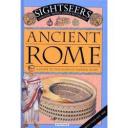Introduction and Summary:
Ancient Rome: A Guide to the Glory of Imperial Rome written by Jonathan Stroud and illustrated by Inklink Firenze and Kevin Maddison is a fascinating book about what life was like in ancient Rome written in the form of a travel guide. If you were traveling back in time, and needed to know what to do in Rome, this book is a must. Stroud covers many topics such as, what to wear, food and drink, shopping, accommodations, and the baths. For entertainment, he discusses the theater, Circus Maximus, and the Colosseum. There is a fold out map in the back of the guide as well as an index and “Souvenir quiz.” Each of the chapters contains a great deal of detailed information with illustrations, and contains a “Sightseers’ Tip.” Examples are “Watch out! The steam baths are heated by air from underground furnaces, so the floor tiles are very hot. You might want to wear sandals to protect your feet,” (p. 16) and “try to buy some fresh honey from one of the estate’s beehives. It’s the only way to sweeten your food.” (p.26) Stroud does a great job explaining the caste system of ancient Rome. The vast majority of Rome’s inhabitants were poor and/or bound to slavery while some citizen’s were very rich. He gives examples of what you can do in the city if you are rich compared to if you are poor. The rich managed to keep the masses happy by paying the poor people’s fees in order to gain popularity. These fees were for using the baths which “are an essential part of life in Rome.” (p.16) The rich also payed for fees for entry to the theatre, the Circus Maximus, and the Colosseum. One million people lived in ancient Rome during the emperor Hadrian’s reign. One big surprise was that the emperor had to import grain from Africa in order to feed all of the people. Stroud also speaks of the famous aqueducts that supplied Rome with over 40 million gallons of water every day. (p.26)
Curriculum Connections:
Emperors had absolute power at this time according to Stroud. However, Magistrate’s were officially elected to public posts by Rome’s citizens. “Wealthy young men follow political careers, as lawyers, magistrates, and finally, as the governors of far-flung regions of the empire.” (p. 28) Teachers can make comparison’s between Rome’s and our political processes of today. (VA SOL 3.1) Student’s will also find that the Roman citizen’s liked to be entertained as much as we do. Men performed as actors on stage. Some of the plays were pretty brutal. In some tragedies, real-life criminals would be executed on stage. At Circus Maximus, chariot races would take place and there would be many wrecks, much like today’s car races. At the Colosseum, two men would fight to the death with sword’s and armor. This would be similar to today’s boxing and mixed martial arts fighting. There was also gambling. (VA SOL 3.1) The Roman’s were very advanced as far as their architecture to meet their environmental needs. They had sidewalks so that people did not have to walk in the mud and sewage in the streets and they built aqueducts to transport millions of gallon of water into the cities daily. (VA SOL 3.4c) The fold-out map at the end of the book showed where the famous Roman landmarks were in the city, as well as the huge expanse of the empire throughout Europe and North Africa. (VA SOL 3.4a)
Additional Resources:
Roman Games — This website has several games and activities for elementary students to learn more about the Roman Empire.
Roman Roles — This website talks about the roles of Roman men, woman and children in ancient times. There is also an activity at the end.
The Roman Empire is a site geared especially for kids. There are several activities, maps, and time periods children can explore.
Roman Gods and Goddesses— Children can learn about ancient Roman religion by learning about the gods and goddesses the Romans worshiped.
General Information:
Book: Ancient Rome: A Guide to the Glory of Imperial Rome
Author: Jonathan Stroud
Illustrator: Inklink Firenze and Kevin Maddison (not available)
Publisher: KINGFISHER
Publication Date: 2000
Pages: 32
Grade Ranges: 3rd & 4th
ISBN: 0-7534-5235-9

